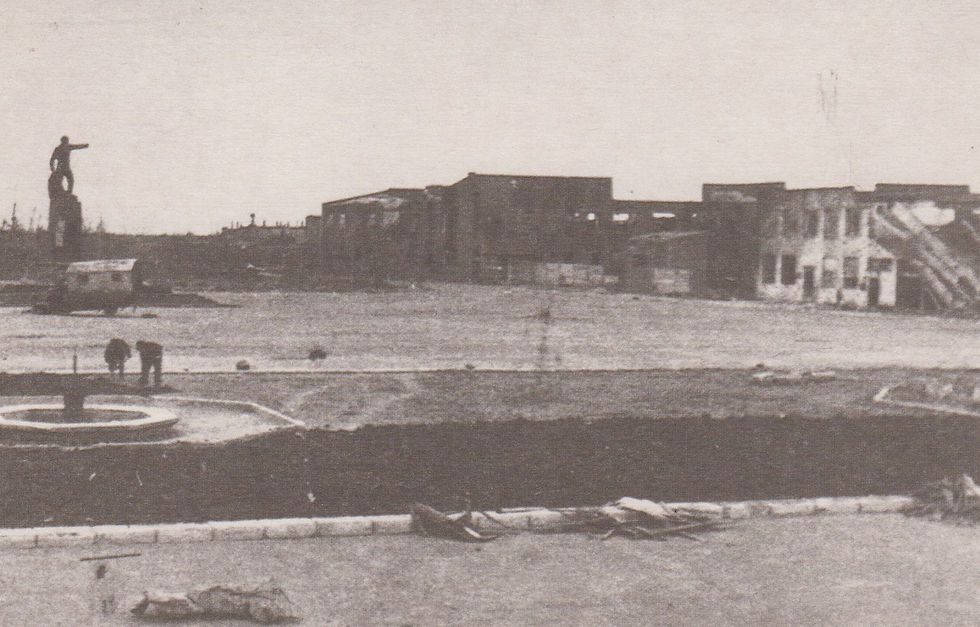Victory at Stalingrad! - Photos of war, resistance and renaissance
- Michael Laxer
- Feb 2, 2021
- 4 min read
A look at the Hero City of Volgograd / Stalingrad in war and peace. On February 2, 1943 the Nazis left in the city surrendered and the Red Army turned the tide against the Germans.

On February 2, 1943 the last of the Nazi generals at Stalingrad (General Strecker) surrendered.
The Soviet Red Army, after the largest battle in human history, had delivered a defeat to the Nazis and their allies from which they would never recover.
While many terrible losses and battles lay ahead, the path forward to victories like Kursk and then ultimately Berlin, had begun to be laid.
The sacrifices, courage and resilience of the men and women of the Red Army and the Soviet people at Stalingrad is almost unimaginable and without them it is very likely the Nazis would have won the war.
In 1973, 30 years later, this folder of illustrated cards was published in honour of those who fought in the battle and the city. It also shows the city's remarkable recovery after the war with contrasting images of the days of destruction and Volgograd in the early 70s.
It includes images like the Motherland Calls, the Hall of Glory, the monument in honour of Rubén Ruiz Ibárruri, the tank monument in front of the Dzerzhinsky Tractor Works, Pavlov's House and many more.

The Motherland Calls / Stand to the Death statue / Heroes Square

Soldier with the victory flag on Mamayev Kurgan, Stalingrad, February 1, 1943 - In a photo dated February 1, 1943, a Red Army soldier celebrates on the height of Mamayev Kurgan that looked over the battlefield of Stalingrad. The height had been a strategic objective that saw terrible fighting for months. The Red Army took it for the last time on January 26, 1943.

Grief Obelisk - during the Battle of Stalingrad, Bald Mountain was a place of fierce fighting. Now here a monument is erected / Monument to Chekists - Erected on the right bank of the Tsaritsa River in memory of the soldiers of the 10th division of the NKVD troops, / Tank Monument to the meeting of the Don troops and troops of the Stalingrad front - the monument honours the day of the encirclement that trapped the Nazis troops in Stalingrad.

Defense Square. March 1943

Obelisk to the Red Soldiers of the Revolution / Monument in honour of Rubén Ruiz Ibárruri who lost his life fighting heroically at Stalingrad. He was the son of famed Spanish Communist leader Dolores Ibárruri / Eternal Flame Monument

Square of the Fallen Fighters. January 1943

Tank Monument outside the Dzerzhinsky Tractor Works - during the battle the factory was switched to tank production. Tanks were literally driven off the assembly line, manufactured under fire, straight into the fighting. / The tractors of the factory after the war. On the centenary of Lenin's birth the pant built its 1,000,000th tractor.

The same square in February 1943

Military Hall of Glory - The hall is decorated with multicolored mosaics. On the names at half-mast are inscribed soldiers who fell in the Battle of Stalingrad. / Mother's Sorrow sculpture - The woman bowed in boundless sorrow over the body of the murdered son. The face of the deceased warrior is covered with a banner.

The mound at Mamayev Kurgan, February 1943

The Guardsmen Cinema - one of twenty cinemas in Volgograd / Hotel / Young People's Theatre / River Bridge - connects Lenin Avenue with Workers 'and Peasants' Street

Centre city street, 1943

Central thoroughfare in summer.

The same area a scene of utter devastation even still in 1948

Central Embankment - The embankment is two-tiered with one at the riverside and one higher up. Note the river hydrofoil in the background.

The area of the embankment in 1943

22nd Congress of the CPSU Stalingrad/Volgograd Hydroelectric Power Station - Built where a workers' battalion battled the invaders / Volga-Don Canal Gateway named for Lenin

Red Army Marines land on the banks of the Volga where the hydroelectric station now is, October 1942

Gogol St. - thousands of visitors arrive by train to visit the Hero City every day

Station Square. January 31, 1943

The Maxim Gorky Theatre - the largest in the city its hall accommodates 1,100 spectators / Planetarium / One of the city's 27 bookshops - this one specialized in political books

The Maxim Gorky Theatre February 4, 1943

Central Department Store - There are 840 different shops in the city. The most important of them is the TSUM. In the basement of the TSUM on January 31, 1943 ingloriously ended the activities of the headquarters of the 6th German Army led by Field Marshal Paulus / The Market on Central Square - The buildings of the market are peculiar. They are built from prefabricated reinforced concrete and glass.

Soviet soldiers on the square in front of the department store, 1943

Monument to Viktor Kholzunov - Kholzunov was a renowned commander of the air
brigade that fought in the skies of Spain during the Civil War. He died in 1939. This monument was erected even before the war. / Staircase from the Volga embankment.

The monument in 1943.

The Defense Museum / Fragment from the painting "Fight on Mamayev Kurgan"

The museum in 1943

V. I. Lenin Square / Friendship Fountain

Pavlov's House - A fortified apartment building which Red Army defenders held for an astounding 60 days despite being surrounded by and under constant attack from the Germans. It was named after Yakov Pavlov the platoon commander who led its defense. After the war Pavlov joined the Communist Party and was elected three times as Deputy to the Supreme Soviet of the Russian Soviet Federative Socialist Republic.





Commenti